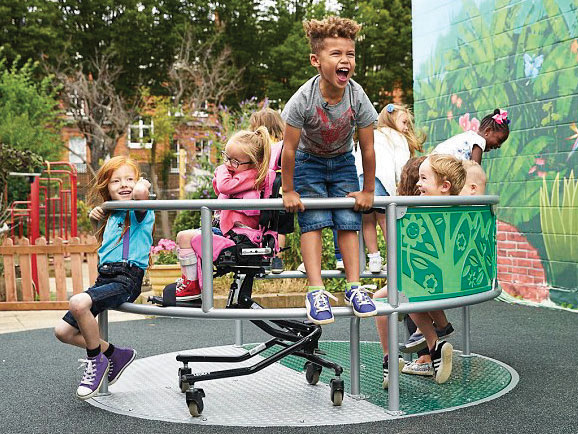Inclusive Playgrounds
Inclusive Playground
CADENCE designs, develops and manufactures innovative play products which offer choice and challenge, enabling children to play and learn together regardless of any impairment.
People with impairments are disabled by the fact that they are excluded from participation within the mainstream of society,as a result of physical, organisational and attitudinal barriers. Our products and play area designs are fully accessible and inclusive. We look at playground elements that might be preventing children and adults from accessing enjoyable play opportunities.
A fully inclusive playground promotes the social model of disability where barriers to play are designed out. It enables self esteem and builds confidence as well as encouraging independence. By letting social and physical barriers disappear in our playgrounds, we can provide equal play opportunities for all using the Six Senses of Inclusive Playground. We develop our product, with an Inclusive focus.
Our design methodology PiPA (Plan Inclusive Play Areas) and fully inclusive product portfolio makes us unique in the play industry.
We are passionate about designing and promoting fully inclusive play spaces and are here to help you create yours.

PiPA (Plan Inclusive Play Areas)
PiPA helps you design Inclusive Playspaces. It evaluates existing play provisions, and is the go-to tool when designing new inclusive play areas.
Finding facilities the whole family can enjoy together can often be a real challange. Our checklist and online PiPA Map, will help you create and find Inclusive Play areas.
Our comprehensive five point system helps inform new play space design, guiding you to select the right equipment for a wide range of different needs, you can be sure your design will be fully inclusive for all ages and abilities. PiPA can also be used to audit existing play spaces, identifying the gaps in provision or barriers to accessibility in the landscape.
Not only does PiPA review the play opportunities provided within a space. It assesses how you access the play area, the availability of information about the space and access to onsite local facilities and amenities. These key areas help illustrate the considerations families of children with disabilities must keep in mind before planning a trip to a play area. Awarded sites can achieve either Gold, Silver or Bronze status and are added to our online interactive map to help families find great community spaces that meet their needs.


Six Senses of Inclusive Playground
Sensory Play engages all children and stimulates receptors for every child.
Sensory Play ensures the play experience involves the entire body even when a child cannot necessarily physically involve themselves in every activity. In your playground, you should consider how many senses are engaged from both a seated and a standing position. We recommend a minimum of three, though more is better!
The PiPA Checklist tool will ensure that your play space is accessible, provides appropriate levels of risk and challenge guaranteeing the correct sensory stimulation for all children, regardless of ability.
Our Six Senses Wheel explains the different sensory receptors and this key is used throughout our Inclusive Play catalogue to help you identify the appropriate play products for your play space. This is fundamental to our Inclusive Play design philosophy.


Smell
Contributes to enjoyment of life by enhancing social activities

Sound
Aids cognitive progression by developing the ability to process

Sight
Aids cognitive progression by developing the ability to process

Proprioception
Awareness of self and joints

Vestibular
Aids cognitive progression by developing the ability to process

TouCh
Develops the visual sense, helping children arrive at appropriate